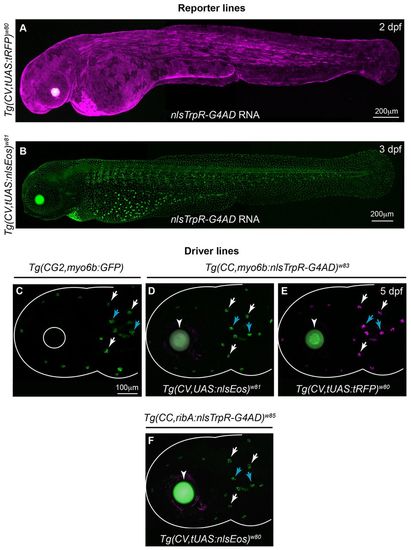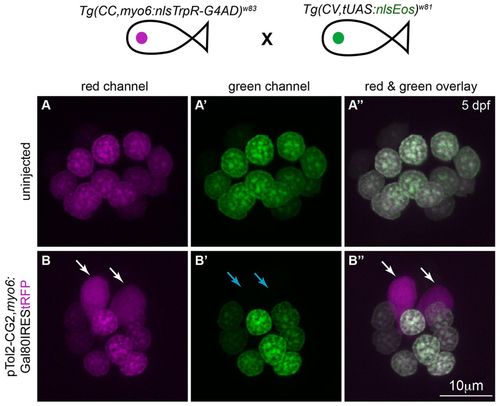- Title
-
A targeted gene expression system using the tryptophan repressor in zebrafish shows no silencing in subsequent generations.
- Authors
- Suli, A., Guler, A.D., Raible, D.W., Kimelman, D.
- Source
- Full text @ Development
|
Transgenic zebrafish lines. (A,B) Two and 3 day post-fertilization (dpf) embryos from reporter lines visualized by injection of nlsTrpR-G4AD mRNA into one-cell stage embryos. (C) Expression pattern of the myo6b promoter visualized by GFP in a transgenic line. (D-F) Driver lines crossed to reporter lines. Heads of 5 dpf double-transgenic zebrafish larvae showing expression of reporter genes in hair cells. The myo6b promoter drives expression in vestibular (blue arrows) and auditory hair cells and lateral line hair cells (white arrows) (D,E), whereas the ribA promoter drives expression in vestibular (blue arrows) and auditory hair cells, lateral line hair cells (white arrows), bipolar and photoreceptor cells (obscured by retinal pigment cells) and pineal cells (not shown) (F). The lens expression is also visible in D-F (white arrowheads). |
|
tUAS is not silenced, as determined by assessing individuals from the F3 generation of the Tg(CV,tUAS:tRFP)w80 reporter line. Eighteen adults from the F3 generation of Tg(CV,tUAS:tRFP)w80 were crossed to the F2 generation of Tg(CC,myo6b:nlsTrpR-G4AD)w83. Progeny double positive for red lenses (indicating the driver line; A, arrow) and green lenses (indicating the reporter line; B, arrow) were sorted out and scored for overall hair cell expression. A single embryo is presented (A, red channel; B, green channel) showing lens expression (A,B) and hair cell expression (A). Of the combined progeny double positive for red and green lens expression, 24.8% (171/690) were also positive for hair cell expression. None was positive for both lens markers but negative for hair cell expression. |
|
tUAS is not silenced across generations of two reporter lines. One adult from each F1-F4 generation of the Tg(CV,tUAS:tRFP)w80 reporter line or F1-F3 generations of the Tg(CV,tUAS:nlsEos)w81 reporter line was crossed to an F2 or F3 adult from Tg(CC,myo6b:nlsTrpR-G4AD)w83. Progeny double positive for the lens markers were sorted out and stained for Parvalbumin, which labels mature hair cells. Head neuromasts, which consist of hair cell clusters, were scored for tRFP (magenta) and Parvalbumin (green) expression (A-D) or nlsEos (green) and Parvalbumin (magenta) expression (F-H). In each case, 5 neuromasts from each of 5 embryos at 5 dpf were analyzed producing a total of 25 total neuromasts. (A-D) A representative neuromast across four generations Tg(CV,tUAS:tRFP)w80 showing tRFP and Parvalbumin (Parv) expression. In each case, the representative neuromast was located over the otic vesicle. (E) The ratio of tRFP/Parv positive hair cells was not statistically different across the generations of the reporter line, showing that tUAS is not silenced. One-way ANOVA, F=0.7655, R2=0.02336, P=0.5161. Tukey’s pairwise column comparison post-test shows no significant differences between any of the columns. (F-H) A representative neuromast showing nlsEos and Parv expression across three generations of Tg(CV,tUAS:nlsEos)w81. (I) The ratio of nlsEos/Parv positive hair cells was always equal or above 100%, showing that across generations all mature cells (Parv positive) also expressed nlsEos. Because Parvalbumin is a late marker for mature hair cells, some nlsEos-positive cells were Parv negative, which most likely indicates the presence of immature hair cells in these samples. Error bars show s.e.m. |
|
Gal80 can inhibit nlsTrpR-G4AD. Adults from F2 generations of Tg(CC,myo6b:nlsTrpR-G4AD)w83 and Tg(CV,tUAS:nlsEos)w81 were crossed, and a subset of embryos was injected with pTol2-CG2,myo6:Gal80IREStRFP. (A-A′) Hair cell nuclei, as visualized by nlsEos, of one neuromast in an uninjected larva. Note that, because the larvae were not reared in the dark, a portion of nlsEos, which is usually detected in the green channel, was photoconverted and nlsEos was detected in both the green channel (A′) and in the red channel (A). (B-B′) A neuromast in a larva injected with pTol2-CG2,myo6:Gal80IREStRFP. Cells with cytoplasmic tRFP (white arrows, B,B′), which express Gal80, have no nlsEos expression (blue arrows, B′), showing that Gal80 can inhibit Gal4 in the TrpR/tUAS system. |




